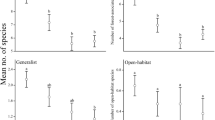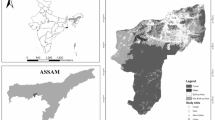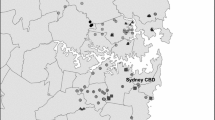Abstract
Continuous large forests intermingled with small patches of open ecosystems (e.g. peatlands) are typical in temperate mountain regions. They are usually removed when cities are installed, but patches remain inside. Moreover, the constant growth of cities threatens the surrounding natural landscapes. Urbanization and land-use change generates degradation of natural habitats, and loss of biodiversity and ecosystem services. In this context, we assessed arachnid diversity in non-urban, peri-urban and urban forests and peatlands in Ushuaia city (Argentina) to evaluate the effect of urbanization in these habitats. We evaluated spider abundance, richness, Exponential of Shannon Entropy (Exp(H)), Simpson Diversity (D), similarity indices and composition. Also, we explored the association between spider assemblage, urbanization categories in each habitat type and local characteristics. We installed 115 pitfall traps, and collected 2589 individuals identified in 50 species from 14 families (including Opiliones and pseudoscorpions). Urbanization had significant effects on abundance and D in both habitat types, with higher abundances in non-urban than urban and peri-urban, and higher D in peri-urban than no-urban and intermediate values in urban. Meanwhile, richness, Exp(H) and D differed between habitats, with consistent higher values in peatlands than forests. At species level, composition was different among urbanization categories, with some species lost (species that only occur in non-urban category) and gains (species that only occur in urban and peri-urban categories). In both habitats, spider assemblages of urbanizations were better correlated with vascular plant cover, with woody debris + litter cover most significantly and positively related to spiders in non-urban forests, and bryophyte cover more related to spiders in non-urban peatlands. We conclude that urban forest fragments and peatlands were able to conserve some of the arachnid diversity characteristic of natural habitats, but homogenization mediated by urbanization exists, which could affect arachnid community functions and conservation.
Implication for insect conservation Our results show that urbanized habitats must undergo long-term monitoring, because although certain species are preserved, some specialists were present only in natural remnants, while others showed an affinity with urbanized habitats only. The species replaced due to possible inter-specific competition, niche modification, or both can lead to the impoverishment of the arachnid fauna. Therefore, urban planning should consider strategies to preserve and restore these semi-natural habitats to promote the conservation of these natural predators.




Similar content being viewed by others
References
Achury R, Chacón de Ulloa P, Arcila A, Suarez AV (2020) Habitat disturbance modifies dominance, coexistence, and competitive interactions in tropical ant communities. Ecol Entomol 45:1247–1262. https://doi.org/10.1111/een.12908
Aisen S, Werenkraut V, González Márquez ME, Ramírez MJ, Ruggiero A (2017) Environmental heterogeneity, not distance, structures montane epigaeic spider assemblages in north-western Patagonia (Argentina). J Insect Conserv 21:951–962. https://doi.org/10.1007/s10841-017-0034-8
Alaruikka D, Kotze DJ, Matveinen K, Niemelä J (2002) Carabid beetle and spider assemblages along a forested urban-rural gradient in southern finland. J Insect Conserv 6:195–206
Argañaraz CI, Gleiser RM (2017) Does urbanization have positive or negative effects on crab spider (Araneae: Thomisidae) diversity? Zoologia 34. https://doi.org/10.3897/zoologia.34.e19987
Argañaraz CI, Martínez Pastur GJ, Ramírez MJ, Grismado CJ, Blazina AP, Lencinas MV (2020a) Ground-dwelling spiders and understory vascular plants on Fuegian austral forests: community responses to variable retention management and their association to natural ecosystems. For Ecol Manage 474. https://doi.org/10.1016/j.foreco.2020.118375
Argañaraz CI, Rubio GD, Rubio M, Castellarini F (2020b) Ground-dwelling spiders in agroecosystems of the dry Chaco: a rapid assessment of community shifts in response to land use changes. https://doi.org/10.1080/14888386.2020.1831605. Biodiversity
Avalos G, Rubio GD, Bar ME, Damborsky MP (2006) A preliminary species checklist of spider (Arachnida: Araneae) from Center North of Corrientes province, Argentina. Rev Iber Aracnol 13:189–194
Benitez J, Lencinas MV, Huertas Herrera A, Martínez Pastur G (2019) Assessing the conservation value of nature reserves: terrestrial birds in Isla de los Estados (Staten Island) Provincial Reserve, Tierra del Fuego, Argentina. Community Ecol 20:2. https://doi.org/10.1556/168.2019.20.2.8
Benitez J, Pizarro JC, Blazina AP, Lencinas MV (2021) Response of bird communities to native forest urbanization in one of the southernmost city of the world. Urban For Urban Gree 58. https://doi.org/10.1016/j.ufug.2020.126887
Blandenier G, Bruggisser OT, Rohr RP, Bersier LF (2013) Are phenological patterns of ballooning spiders linked to habitat characteristics? J Arachnol 41:126–113. https://doi.org/10.1636/P12-48
Cárcamo JR, Contador T, Gañán M, Convey P, Kennedy J, Rozzi R (2019) Altitudinal gradients in magellanic sub-antarctic lagoons: the effect of elevation on freshwater macroinvertebrate diversity and distribution. Peerj 7. https://doi.org/10.7717/peerj.7128
Chao A, Chiu CH, Jost L (2014) Unifying species diversity, phylogenetic diversity, functional diversity, and related similarity and differentiation measures through hill numbers. Annu Rev Ecol Evol Syst 45:297–324. https://doi.org/10.1146/annurev-ecolsys-120213-091540
Chao A, Ma KH, Hsieh TC, Chiu CH (2015) Online Program SpadeR (Species-richness Prediction And Diversity Estimation in R). Program and User’s Guide published at http://chao.stat.nthu.edu.tw/wordpress/software_download/
Chao A, Ma KH, Hsieh TC (2016) iNEXT (iNterpolation and EXTrapolation) Online: Software for Interpolation and Extrapolation of Species Diversity. Program and User’s Guide published at http://chao.stat.nthu.edu.tw/wordpress/software_download/
Chao A, Kubota Y, Zelený D, Chiu C-H, Li C-F, Kusumoto B et al (2020) Quantifying sample completeness and comparing diversities among assemblages. Ecol 35. https://doi.org/10.1111/1440-1703.12102
Corcuera P, Valverde PL, Jiménez ML, Ponce-Mendoza A, De la Rosa G, Nieto G (2015) Ground spider guilds and functional diversity in native pine woodlands and eucalyptus plantations. Environ Entomol. https://doi.org/10.1093/ee/nvv181
Coulson JC, Butterfield J (1986) The spider communities on peat and upland grassland in northern England. Holarct Ecol 9:229–239
Crawley MJ (2015) Statistics: An introduction Using R. Second Edition, Wiley
de la Delgado YA, Perry KI, Turo KJ, Parker DM, Thompson JL, Gardiner MM (2020) Local and landscape-scale environmental filters drive the functional diversity and taxonomic composition of spiders across urban greenspaces. J Appl Ecol 1–11. https://doi.org/10.1111/1365-2664.13636
Frangi J, Richter L (1992) Los ecosistemas forestales de la Tierra del Fuego. Vida Silvestre (ICONA, España) 72 2° sem, 36–43
Grismado C, Ramírez MJ, Izquierdo MA (2014) “Araneae: taxonomía, diversidad y clave de identificación de familias de la Argentina” in Biodiversidad de Artrópodos Argentinos volumen 3 eds. In: Roig-Juñent S, Claps LE, Morrone JJ (eds) San Miguel de Tucumán. INSUE – UNT), Argentina, pp 55–94
He C, Liu Z, Tian J, Ma Q (2014) Urban expansion dynamics and natural habitat loss in China: a multiscale landscape perspective. Glob Chang Biol 20:9. https://doi.org/10.1111/gcb.12553
INDEC (2010) Censo Nacional De Población, Hogares y Viviendas (2010) Documento Metodológico Preliminar. Available at: http://censo2010.indec.gov.ar/metodologia.asp. Accessed 1 Apr 2022
Jones EL, Leather SR (2012) Invertebrates in urban areas: a review. Eur J Entomol 109:463–478. https://doi.org/10.14411/eje.2012.060
Joosten H, Clarke D (2002) Wise Use of Mires and Peatlands: background and principles including a framework for decision making. NHBS Ltd., Totnes
Kreps G, Martínez Pastur G, Peri PL (2012) Cambio climático en Patagonia Sur: Escenarios futuros en el manejo de los recursos naturales. Ediciones INTA, Buenos Aires
Lencinas MV, Martínez Pastur G, Medina M, Busso C (2005) Richness and density of birds in timber Nothofagus pumilio forests and their unproductive associated environments. Biodiv Conserv 14:2299–2320. https://doi.org/10.1007/s10531-004-1665-0
Lencinas MV, Martínez Pastur G, Anderson CB, Busso C (2008a) The value of timber quality forests for insect conservation on Tierra del Fuego Island compared to associated non-timber quality stands. J Ins Conserv 12:461–475. https://doi.org/10.1007/s10841-007-9079-4
Lencinas MV, Martínez Pastur G, Rivero P, Busso C (2008b) Conservation value of timber quality versus associated non-timber quality stands for understory diversity in Nothofagus forests. Biod Conserv 17:2579–2597. https://doi.org/10.1007/s10531-008-9323-6
Lencinas MV, Martínez Pastur G, Gallo E, Cellini JM (2014) Decreasing negative impacts of harvesting over insect communities using variable retention in southern Patagonian forests. J Insect Conserv 18:479–495. https://doi.org/10.1007/s10841-014-9661-5
Lencinas MV, Kreps G, Soler R, Peri PL, Porta A, Ramírez M, Martínez Pastur G (2015) Neochelanops michaelseni (Pseudoscorpiones: Chernetidae) as a potential bioindicator in managed and unmanaged Nothofagus forest of Tierra del Fuego. J Arachnol 43:406?412. https://doi.org/10.1636/0161-8202-43.3.406
Lencinas MV, Sola FJ, Martínez Pastur G (2017) Variable retention effects on vascular plants and beetles along a regional gradient in Nothofagus pumilio forests. For Ecol Manage 406:251–265. https://doi.org/10.1016/j.foreco.2017.10.014
Lencinas MV, Sola FJ, Cellini JM, Peri PL, Martínez Pastur GJ (2019) Land sharing in South Patagonia: conservation of above-ground beetle diversity in forests and non-forest ecosystems. Sci Total Environ 690:132–139. https://doi.org/10.1016/j.scitotenv.2019.06.517
León CA, Gabriel M, Rodríguez C, Iturraspe R, Savoretti A, Pancotto V et al(2021) Peatlands of Southern South America: a review. Mires and Peat 27:3. https://doi.org/0.19189/MaP.2020.SNPG.StA.2021
Lepczyk CA, Aronson MFJ, Evans KL, Goddard MA, Lerman SB, MacIvor JS (2017) Biodiversity in the City: fundamental questions for understanding the Ecology of Urban Green Spaces for Biodiversity Conservation. Bioscience 67:9. https://doi.org/10.1093/biosci/bix079
Lyons A, Ashton PA, Powell I, Oxbrough A (2018) Epigeal spider assemblage responses to vegetation structure under contrasting grazing management in upland calcareous grasslands. Insect Conserv Divers 11. https://doi.org/10.1111/icad.12287
Magura T, Horváth R, Tóthmérész B (2010) Effects of urbanization on ground-dwelling spiders in forest patches, in Hungary. Landsc Ecol 25. https://doi.org/10.1007/s10980-009-9445-6
Magurran AE (1988) Ecological diversity and its measurement. Springer Dordrecht, Berlin, Germany. https://doi.org/10.1007/978-94-015-7358-0
Martínez Pastur GJ, Cellini JM, Lencinas MV, Barrera M, Peri PL (2011) Environmental variables influencing regeneration of Nothofagus pumilio in system with combined aggregated and dispersed retention. For Ecol Manage 261:178–186. https://doi.org/10.1016/j.foreco.2010.10.002
McKinney ML (2006) Urbanization as a major cause of biotic homogenization. Biol Conserv 127. https://doi.org/10.1016/j.biocon.2005.09.005
Mellinger RL, Braschler B, Rusterholz HP, Baur B (2018) Diverse effects of degree of urbanisation and forest size on species richness and functional diversity of plants, and ground surface-active ants and spiders. PLoS ONE 13:6. https://doi.org/10.1371/journal.pone.0199245
Moore DM (1983) Flora of Tierra del Fuego. Anthony Nelson, United Kingdom
Noreika N, Pajunen T, Kotze DJ (2015) Urban mires as hotspots of epigaeic arthropod diversity. Biodivers Conserv 24. https://doi.org/10.1007/s10531-015-0990-9
Olden JD, Poff NL (2004) Ecological processes driving biotic homogenization: testing a mechanistic model using fish faunas. Ecology 85:1867–1875
Otto C, Svensson BS (1982) Structure of communities of ground-living spider along altitudinal gradients. Holarct Ecol 5:35–47
Peng MH, Hung YC, Liu KL, Neoh KB (2020) Landscape configuration and habitat complexity shape arthropod assemblage in urban parks. Sci Rep 10:16043. https://doi.org/10.1038/s41598-020-73121-0
R Core Team (2021) R: A language and environment for statistical computing. R Foundation for Statistical Computing, Vienna, Austria. URL https://www.R-project.org/
Rahbek C (2005) The role of spatial scale and the perception of large-scale species-richness patterns. Ecol Lett 8:224–239. https://doi.org/10.1111/j.1461-0248.2004.00701.x
Sola FJ, Peri PL, Huertas L, Martínez Pastur GJ, Lencinas MV (2016) Above-ground arthropod community structure and influence of structural-retention management in southern Patagonian scrublands, Argentina. J Insect Conserv 20:929–944. https://doi.org/10.1007/s10841-016-9918-2
Soler R, Benítez J, Sola F, Lencinas MV(2022) Biodiversity Islands at the World’s Southernmost City: Plant, Bird and Insect Conservation in Urban Forests and Peatlands of Ushuaia, Argentina. In: Montagnini, F. (Ed.). Biodiversity Islands: Pockets of Protected Land in Human Dominated Environments. Springer. 709 pp
Stendera SES, Johnson RK (2005) Additive partitioning of aquatic invertebrate species diversity across multiple spatial scales. Freshw Biol 50:1360–1375. https://doi.org/10.1111/j.1365-2427.2005.01403.x
Tajthi B, Horváth R, Mizser Sz, Nagy DD, Tóthmérész B (2017) Spider assemblages in floodplain forests along an urbanization gradient. Community Ecol 18:3. https://doi.org/10.1556/168.2017.18.3.10
Wang H, He Q, Liu X, Zhuang Y, Hong S (2011) Global urbanization research from 1991 to 2009: a systematic research review. Landsc Urban Plan 104. https://doi.org/10.1016/j.landurbplan.2011.11.006
Zhang D, Huang Q, He C, Wu J (2017) Impacts of urban expansion on ecosystem services in the Beijing-Tianjin-Hebei urban agglomeration, China: a scenario analysis based on the Shared Socioeconomic Pathways. https://doi.org/10.1016/j.resconrec.2017.06.003. Resour Conserv Recy 125
Acknowledgements
We would like to thank Dr. Martín Ramírez and Abel Pérez González for their help during arachnid determinations.
Funding
This work was conducted with funds provided by PICT2016–1968, from ANPCyT-Argentina.
Author information
Authors and Affiliations
Contributions
CIA: processed and analyzed the arachnid data, wrote the first draft of the manuscript, reviewed and edited the manuscript. JB, RS and FS: conceived the project, collected the data, critically read the manuscript. MVL: conceived the project, obtained the funds, supervised the project, drafted and refined the manuscript. All authors read, edited, and approved the final manuscript.
Corresponding author
Ethics declarations
Competing interests
The authors have no competing interests.
Additional information
Publisher’s Note
Springer Nature remains neutral with regard to jurisdictional claims in published maps and institutional affiliations.
Electronic supplementary material
Below is the link to the electronic supplementary material.
Rights and permissions
Springer Nature or its licensor (e.g. a society or other partner) holds exclusive rights to this article under a publishing agreement with the author(s) or other rightsholder(s); author self-archiving of the accepted manuscript version of this article is solely governed by the terms of such publishing agreement and applicable law.
About this article
Cite this article
Argañaraz, C.I., Benitez, J., Soler, R. et al. Urbanization effect of homogenization on ground-dwelling arachnids’ diversity in natural forest and peatland remnants. J Insect Conserv 27, 283–294 (2023). https://doi.org/10.1007/s10841-022-00453-9
Received:
Accepted:
Published:
Issue Date:
DOI: https://doi.org/10.1007/s10841-022-00453-9




